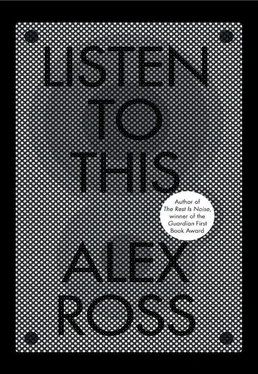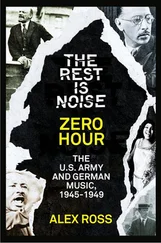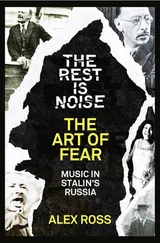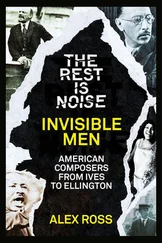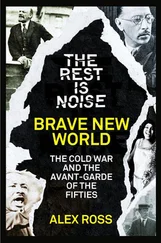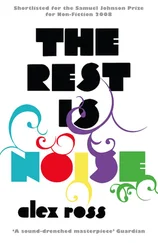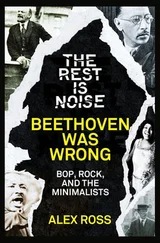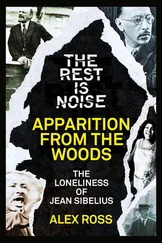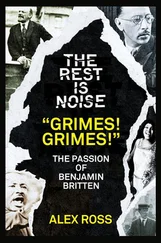The Great Soviet Encyclopedia, in one of its saner moments, defined music as “a specific variant of the sound made by people.” The difficult thing about music writing, in the end, is not to describe a sound but to describe a human being. It’s tricky work, presumptuous in the case of the living and speculative in the case of the dead. Still, I hope to give a few lingering glimpses of all those sensuous selves.
PART I
1 LISTEN TO THIS CROSSING THE BORDER FROM CLASSICAL TO POP
I hate “classical music”: not the thing but the name. It traps a tenaciously living art in a theme park of the past. It cancels out the possibility that music in the spirit of Beethoven could still be created today. It banishes into limbo the work of thousands of active composers who have to explain to otherwise well-informed people what it is they do for a living. The phrase is a masterpiece of negative publicity, a tour de force of anti-hype. I wish there were another name. I envy jazz people who speak simply of “the music.” Some jazz aficionados also call their art “America’s classical music,” and I propose a trade: they can have “classical,” I’ll take “the music.”
For at least a century, the music has been captive to a cult of mediocre elitism that tries to manufacture self-esteem by clutching at empty formulas of intellectual superiority. Consider other names in circulation: “art” music, “serious” music, “great” music, “good” music. Yes, the music can be great and serious, but greatness and seriousness are not its defining characteristics. It can also be stupid, vulgar, and insane. Composers are artists, not etiquette columnists; they have the right to express any emotion, any state of mind. They have been betrayed by well-meaning acolytes who believe that the music should be marketed as a luxury good, one that replaces an inferior popular product. These guardians say, in effect, “The music you love is trash. Listen instead to our great, arty music.” They are making little headway with the unconverted because they have forgotten to define the music as something worth loving. Music is too personal a medium to support an absolute hierarchy of values. The best music is the music that persuades us that there is no other music in the world.
When people hear “classical,” they think “dead.” The music is described in terms of its distance from the present, its difference from the mass. No wonder that stories of its imminent demise are commonplace. Newspapers recite a familiar litany of problems: record companies are curtailing their classical divisions; orchestras are facing deficits; the music is barely taught in public schools, almost invisible in the media, ignored or mocked by Hollywood. Yet the same story was told forty, sixty, eighty years ago. Stereo Review wrote in 1969, “Fewer classical records are being sold because people are dying … Today’s dying classical market is what it is because fifteen years ago no one attempted to instill a love for classical music in the then impressionable children who have today become the market.” The conductor Alfred Wallenstein wrote in 1950, “The economic crisis confronting the American symphony orchestra is becoming increasingly acute.” The German critic Hans Heinz Stuckenschmidt wrote in 1926, “Concerts are poorly attended and budget deficits grow from year to year.” Laments over the decline or death of the art appear as far back as the fourteenth century, when the sensuous melodies of Ars Nova were thought to signal the end of civilization. The pianist Charles Rosen has sagely observed, “The death of classical music is perhaps its oldest continuing tradition.”
The American classical audience is assumed to be a moribund crowd of the old, the white, the rich, and the bored. Statistics provided by the National Endowment for the Arts suggest that the situation is not quite so dire. Yes, the audience is older than that for any other art—the median age is forty-nine—but it is not the wealthiest. Musicals, plays, ballet, and museums all get larger slices of the $50,000-or-more income pie (as does the ESPN channel, for that matter). The parterre section at the Metropolitan Opera plays host to CEOs and socialites, but the less expensive parts of the house—as of this writing, most seats in the Family Circle go for twenty-five dollars—are well populated by schoolteachers, proofreaders, students, retirees, and others with no entry in the Social Register. If you want to see an in-your-face, Swiss-bank-account display of wealth, go look at the millionaires sitting in the skyboxes at a Billy Joel show, if security lets you. As for the graying of the audience, there is no denying the general trend, although with any luck it may begin to level off. Paradoxically, even as the audience ages, the performers keep getting younger. The musicians of the Berlin Philharmonic are, on average, a generation younger than the Rolling Stones.
The music is always dying, ever-ending. It is like an ageless diva on a nonstop farewell tour, coming around for one absolutely final appearance. It is hard to name because it never really existed to begin with—not in the sense that it stemmed from a single time or place. It has no genealogy, no ethnicity: leading composers of today hail from China, Estonia, Argentina, Queens. The music is simply whatever composers create—a long string of written-down works to which various performing traditions have become attached. It encompasses the high, the low, empire, underground, dance, prayer, silence, noise. Composers are genius parasites; they feed voraciously on the song matter of their time in order to engender something new. They have gone through a rough stretch in the past hundred years, facing external obstacles (Hitler and Stalin were amateur music critics) as well as problems of their own invention (“Why doesn’t anyone like our beautiful twelve-tone music?”). But they may be on the verge of an improbable renaissance, and the music may take a form that no one today would recognize.
The critic Greg Sandow has written that the classical community needs to speak more from the heart about what the music means. He admits that it’s easier to analyze his ardor than to express it. The music does not lend itself to the same kind of generational identification as, say, Sgt. Pepper. There may be kids out there who lost their virginity during Brahms’s D-Minor Piano Concerto, but they don’t want to tell the story and you don’t want to hear it. The music attracts the reticent fraction of the population. It is an art of grand gestures and vast dimensions that plays to mobs of the quiet and the shy.
I am a white American male who listened to nothing but classical music until the age of twenty. In retrospect, this seems bizarre; perhaps “freakish” is not too strong a word. Yet it felt natural at the time. I feel as though I grew up not during the seventies and eighties but during the thirties and forties, the decades of my parents’ youth. Neither my mother nor my father had musical training—both worked as research mineralogists—but they were devoted concertgoers and record collectors. They came of age in the great American middlebrow era, when the music had a rather different place in the culture than it does today. In those years, in what now seems like a dream world, millions listened as Toscanini conducted the NBC Symphony on national radio. Walter Damrosch explained the classics to schoolchildren, singing ditties to help them remember the themes. (My mother remembers one of them: “This is / The sym-pho-nee / That Schubert wrote but never / Fi-nished …”) NBC would broadcast Ohio State vs. Indiana one afternoon, a recital by Lotte Lehmann the next. In my house, it was the Boston Symphony followed by the Washington Redskins. I was unaware of a yawning gap between the two.
Читать дальше
